Optimizing Urban Green Spaces for Air Quality Improvement: A Multiscale Land Use/Land Cover Synergy Practical Framework in Wuhan, China
Abstract
:1. Introduction
2. Methodology
2.1. Study Area and Data Processing
2.1.1. Study Area
2.1.2. Data Source and Processing
2.2. Research Framework
2.3. Confusion Matrix and LULC Evolution
2.4. Annual Concentration and Difference Calculation for PM2.5
2.5. Spatial Correlation Analysis
2.6. Spatial Regression Analysis
3. Results
3.1. Spatiotemporal Evolution of LULC and PM2.5
3.1.1. Spatiotemporal Evolution of LULC
3.1.2. Spatiotemporal Evolution of the PM2.5 Concentration and Its Fluctuations
3.2. OLS Results
3.3. MGWR Results
3.3.1. The MGWR Model Exhibits Better Performance
3.3.2. The UGS Conversion Space Shows Unstable Spatial Variable Properties
3.3.3. The 2 km Scale Is a Scientific Scale for Examining Local Spatial Relationships
3.4. Spatial Heterogeneity Impact of UGS Conversion on PM2.5 Changes at the 2 km Scale
3.4.1. Spatiotemporal Pattern of the Local R2 Values
3.4.2. Spatiotemporal Pattern of LRCs between UGS Conversion and PM2.5 Changes
4. Discussion
4.1. Practical Guidance: Multifaceted Spatiotemporal LULC Transformations
4.2. Essential Analysis: Diagnosing Spatial Variable Properties and Research Scales
4.3. Multidimensional Strategy: UGS-LULC Synergy for PM2.5 Mitigation
4.3.1. Synergistic Strategy for UGS and Construction Land
4.3.2. UGS Strategy with Bare Land and Water
5. Conclusions
Supplementary Materials
Author Contributions
Funding
Data Availability Statement
Conflicts of Interest
References
- Shahtahmassebi, A.R.; Li, C.; Fan, Y.; Wu, Y.; Lin, Y.; Gan, M.; Wang, K.; Malik, A.; Blackburn, G.A. Remote Sensing of Urban Green Spaces: A Review. Urban For. Urban Green. 2021, 57, 126946. [Google Scholar] [CrossRef]
- World Health Organization (WHO). New WHO Global Air Quality Guidelines Aim to Save Millions of Lives from Air Pollution. Available online: https://www.who.int/news/item (accessed on 25 November 2023).
- Lu, F.; Xu, D.Q.; Cheng, Y.B.; Dong, S.X.; Guo, C.; Jiang, X.; Zheng, X.Y. Systematic Review and Meta-Analysis of the Adverse Health Effects of Ambient PM2.5 and PM10 Pollution in the Chinese Population. Environ. Res. 2015, 136, 196–204. [Google Scholar] [CrossRef] [PubMed]
- Hu, Z. Spatial Analysis of MODIS Aerosol Optical Depth, PM2.5, and Chronic Coronary Heart Disease. Int. J. Health Geogr. 2009, 8, 27. [Google Scholar] [CrossRef] [PubMed]
- Kwag, Y.; Kim, M.H.; Oh, J.; Shah, S.; Ye, S.; Ha, E.H. Effect of Heat Waves and Fine Particulate Matter on Preterm Births in Korea from 2010 to 2016. Environ. Int. 2021, 147, 106239. [Google Scholar] [CrossRef]
- Coccia, M. Effects of the Spread of COVID-19 on Public Health of Polluted Cities: Results of the First Wave for Explaining the Deja Vu in the Second Wave of COVID-19 Pandemic and Epidemics of Future Vital Agents. Environ. Sci. Pollut. Res. 2021, 28, 19147–19154. [Google Scholar] [CrossRef]
- Paital, B.; Agrawal, P.K. Air Pollution by NO2 and PM2.5 Explains COVID-19 Infection Severity by Overexpression of Angiotensin-Converting Enzyme 2 in Respiratory Cells: A Review. Environ. Chem. Lett. 2021, 19, 25–42. [Google Scholar] [CrossRef] [PubMed]
- Zhu, Y.J.; Xie, J.G.; Huang, F.M.; Cao, L.Q. Association between Short-Term Exposure to Air Pollution and COVID-19 Infection: Evidence from China. Sci. Total Environ. 2020, 727, 138704. [Google Scholar] [CrossRef] [PubMed]
- Cai, L.; Zhuang, M.; Ren, Y. Spatiotemporal Characteristics of NO2, PM2.5 and O3 in a Coastal Region of Southeastern China and Their Removal by Green Spaces. Int. J. Environ. Health Res. 2022, 32, 1–17. [Google Scholar] [CrossRef] [PubMed]
- Chen, M.; Dai, F.; Yang, B.; Zhu, S. Effects of Urban Green Space Morphological Pattern on Variation of PM2.5 Concentration in the Neighborhoods of Five Chinese Megacities. Build. Environ. 2019, 158, 1–15. [Google Scholar] [CrossRef]
- Chen, L.X.; Liu, C.M.; Zou, R.; Yang, M.; Zhang, Z.Q. Experimental Examination of Effectiveness of Vegetation as Bio-Filter of Particulate Matters in the Urban Environment. Environ. Pollut. 2016, 208, 198–208. [Google Scholar] [CrossRef]
- Li, Y.; Zhang, Y.; Wu, Q.; Xue, R.; Wang, X.; Si, M.; Zhang, Y. Greening the Concrete Jungle: Unveiling the Co-Mitigation of Greenspace Configuration on PM2.5 and Land Surface Temperature with Explanatory Machine Learning. Urban For. Urban Green. 2023, 88, 128086. [Google Scholar] [CrossRef]
- Cai, L.Y.; Zhuang, M.Z.; Ren, Y. A Landscape Scale Study in Southeast China Investigating the Effects of Varied Green Space Types on Atmospheric PM2.5 in Mid-Winter. Urban For. Urban Green. 2020, 49, 126607. [Google Scholar] [CrossRef]
- Qiu, L.; Liu, F.; Zhang, X.; Gao, T. Difference of Airborne Particulate Matter Concentration in Urban Space with Different Green Coverage Rates in Baoji, China. Int. J. Environ. Res. Public Health 2019, 16, 1465. [Google Scholar] [CrossRef] [PubMed]
- Moniruzzaman, M.; Thakur, P.K.; Kumar, P.; Ashraful Alam, M.; Garg, V.; Rousta, I.; Olafsson, H. Decadal Urban Land Use/Land Cover Changes and Its Impact on Surface Runoff Potential for the Dhaka City and Surroundings Using Remote Sensing. Remote Sens. 2021, 13, 83. [Google Scholar] [CrossRef]
- Lu, Y.; Yang, X.; Wang, H.; Jiang, M.; Wen, X.; Zhang, X.; Meng, L. Exploring the Effects of Land Use and Land Cover Changes on Meteorology and Air Quality over Sichuan Basin, Southwestern China. Front. Ecol. Evol. 2023, 11, 1131389. [Google Scholar] [CrossRef]
- Li, M.; Song, Y.; Mao, Z.; Liu, M.; Huang, X. Impacts of Thermal Circulations Induced by Urbanization on Ozone Formation in the Pearl River Delta Region, China. Atmos. Environ. 2016, 127, 382–392. [Google Scholar] [CrossRef]
- Javaid, K.; Ghafoor, G.Z.; Sharif, F.; Shahid, M.G.; Shahzad, L.; Ghafoor, N.; Farhan, M. Spatio-Temporal Analysis of Land Use Land Cover Change and Its Impact on Land Surface Temperature of Sialkot City, Pakistan. Sci. Rep. 2023, 13, 22166. [Google Scholar] [CrossRef] [PubMed]
- Yousefi, R.; Shaheen, A.; Wang, F.; Ge, Q.; Wu, R.; Lelieveld, J.; Wang, J.; Su, X. Fine Particulate Matter (PM2.5) Trends from Land Surface Changes and Air Pollution Policies in China during 1980–2020. J. Environ. Manag. 2023, 326, 116847. [Google Scholar] [CrossRef]
- Zhang, P.; Ma, W.; Wen, F.; Liu, L.; Yang, L.; Song, J.; Wang, N.; Liu, Q. Estimating PM2.5 Concentration Using the Machine Learning GA-SVM Method to Improve the Land Use Regression Model in Shaanxi, China. Ecotoxicol. Environ. Saf. 2021, 225, 112772. [Google Scholar] [CrossRef]
- Bi, S.; Dai, F.; Chen, M.; Xu, S. A New Framework for Analysis of the Morphological Spatial Patterns of Urban Green Space to Reduce PM2.5 Pollution: A Case Study in Wuhan, China. Sustain. Cities Soc. 2022, 82, 103900. [Google Scholar] [CrossRef]
- Li, K.; Li, C.; Hu, Y.; Xiong, Z.; Wang, Y. Quantitative Estimation of the PM2.5 Removal Capacity and Influencing Factors of Urban Green Infrastructure. Sci. Total Environ. 2023, 867, 161476. [Google Scholar] [CrossRef] [PubMed]
- Mo, Y.; Booker, D.; Zhao, S.; Tang, J.; Jiang, H.; Shen, J.; Chen, D.; Li, J.; Jones, K.C.; Zhang, G. The Application of Land Use Regression Model to Investigate Spatiotemporal Variations of PM2.5 in Guangzhou, China: Implications for the Public Health Benefits of PM2.5 Reduction. Sci. Total Environ. 2021, 778, 146305. [Google Scholar] [CrossRef] [PubMed]
- Ouyang, W.; Gao, B.; Cheng, H.; Hao, Z.; Wu, N. Exposure Inequality Assessment for PM2.5 and the Potential Association with Environmental Health in Beijing. Sci. Total Environ. 2018, 635, 769–778. [Google Scholar] [CrossRef] [PubMed]
- Yang, H.O.; Chen, W.B.; Liang, Z.F. Impact of Land Use on PM2.5 Pollution in a Representative City of Middle China. Int. J. Environ. Res. Public Health 2017, 14, 462. [Google Scholar] [CrossRef]
- Li, K.; Li, C.; Liu, M.; Hu, Y.; Wang, H.; Wu, W. Multiscale Analysis of the Effects of Urban Green Infrastructure Landscape Patterns on PM2.5 Concentrations in an Area of Rapid Urbanization. J. Clean. Prod. 2021, 325, 129324. [Google Scholar] [CrossRef]
- Li, S.; Zhao, Z.; Xie, M.; Wang, Y. Investigating Spatial Non-Stationary and Scale-Dependent Relationships between Urban Surface Temperature and Environmental Factors Using Geographically Weighted Regression. Environ. Model. Softw. 2010, 25, 1789–1800. [Google Scholar] [CrossRef]
- Niu, L.; Zhang, Z.; Peng, Z.; Liang, Y.; Liu, M.; Jiang, Y.; Wei, J.; Tang, R. Identifying Surface Urban Heat Island Drivers and Their Spatial Heterogeneity in China’s 281 Cities: An Empirical Study Based on Multiscale Geographically Weighted Regression. Remote Sens. 2021, 13, 4428. [Google Scholar] [CrossRef]
- He, H.; Wang, J.; Ding, J.; Wang, L. Spatial Downscaling of Precipitation Data in Arid Regions Based on the XGBoost-MGWR Model: A Case Study of the Turpan–Hami Region. Land 2024, 13, 448. [Google Scholar] [CrossRef]
- Ma, Z.; Huang, Z. A Bayesian Implementation of the Multiscale Geographically Weighted Regression Model with INLA. Ann. Am. Assoc. Geogr. 2023, 113, 1501–1515. [Google Scholar] [CrossRef]
- Shen, H.; Huang, L.; Zhang, L.; Wu, P.; Zeng, C. Long-Term and Fine-Scale Satellite Monitoring of the Urban Heat Island Effect by the Fusion of Multi-Temporal and Multi-Sensor Remote Sensed Data: A 26-Year Case Study of the City of Wuhan in China. Remote Sens. Environ. 2016, 172, 109–125. [Google Scholar] [CrossRef]
- Wu, J.; Yang, S.; Zhang, X. Interaction Analysis of Urban Blue-Green Space and Built-Up Area Based on Coupling Model-A Case Study of Wuhan Central City. Water 2020, 12, 2185. [Google Scholar] [CrossRef]
- Xun, L.; Qingfeng, G.; Clarke, K.C.; Shishi, L.; Bingyu, W.; Yao, Y. Understanding the Drivers of Sustainable Land Expansion Using a Patch-Generating Land Use Simulation (PLUS) Model: A Case Study in Wuhan, China. arXiv 2020, arXiv:2010.11541. [Google Scholar]
- Fan, Z.Y.; Zhan, Q.M.; Liu, H.M.; Wu, Y.H.; Xia, Y. Investigating the Interactive and Heterogeneous Effects of Green and Blue Space on Urban PM2.5 Concentration, a Case Study of Wuhan. J. Clean. Prod. 2022, 378, 134389. [Google Scholar] [CrossRef]
- Lu, M.; Tang, X.; Wang, Z.; Gbaguidi, A.; Liang, S.; Hu, K.; Wu, L.; Wu, H.; Huang, Z.; Shen, L. Source Tagging Modeling Study of Heavy Haze Episodes under Complex Regional Transport Processes over Wuhan Megacity, Central China. Environ. Pollut. 2017, 231, 612–621. [Google Scholar] [CrossRef] [PubMed]
- Yu, C.; Zhao, T.; Bai, Y.; Zhang, L.; Kong, S.; Yu, X.; He, J.; Cui, C.; Yang, J.; You, Y.; et al. Heavy Air Pollution with a Unique “Non-Stagnant” Atmospheric Boundary Layer in the Yangtze River Middle Basin Aggravated by Regional Transport of PM2.5 over China. Atmos. Chem. Phys. 2020, 20, 7217–7230. [Google Scholar] [CrossRef]
- Chen, X.P.; Pei, T.T.; Zhou, Z.X.; Teng, M.J.; He, L.; Luo, M.; Liu, X.X. Efficiency Differences of Roadside Greenbelts with Three Configurations in Removing Coarse Particles (PM10): A Street Scale Investigation in Wuhan, China. Urban For. Urban Green. 2015, 14, 354–360. [Google Scholar] [CrossRef]
- Zhang, M.; Ma, Y.; Gong, W.; Wang, L.; Xia, X.; Che, H.; Hu, B.; Liu, B. Aerosol Radiative Effect in UV, VIS, NIR, and SW Spectra under Haze and High-Humidity Urban Conditions. Atmos. Environ. 2017, 166, 9–21. [Google Scholar] [CrossRef]
- Xu, Y.M.; Smith, S.E.; Grunwald, S.; Abd-Elrahman, A.; Wani, S.P. Incorporation of Satellite Remote Sensing Pan-Sharpened Imagery into Digital Soil Prediction and Mapping Models to Characterize Soil Property Variability in Small Agricultural Fields. ISPRS J. Photogramm. Remote Sens. 2017, 123, 1–19. [Google Scholar] [CrossRef]
- Liu, Z.H.; Zhao, L.; Peng, Y.P.; Wang, G.X.; Hu, Y.M. Improving Estimation of Soil Moisture Content Using a Modified Soil Thermal Inertia Model. Remote Sens. 2020, 12, 1719. [Google Scholar] [CrossRef]
- Dai, F.; Bi, S.B.; Chen, M.; Guo, X.H. Research on Green Space System Pattern Evolution and Its Driving Factors Based on MSPA and Confusion Matrix—Taking London as an Example. Chin. Landsc. Archit. 2020, 36, 34–39. [Google Scholar] [CrossRef]
- Gao, Y.J.; Zhao, J.Y.; Han, L. Exploring the Spatial Heterogeneity of Urban Heat Island Effect and Its Relationship to Block Morphology with the Geographically Weighted Regression Model. Sustain. Cities Soc. 2022, 76, 103431. [Google Scholar] [CrossRef]
- Wei, J.; Li, Z.; Cribb, M.; Huang, W.; Xue, W.; Sun, L.; Guo, J.; Peng, Y.; Li, J.; Lyapustin, A.; et al. Improved 1 km Resolution PM2.5 Estimates across China Using Enhanced Space-Time Extremely Randomized Trees. Atmos. Chem. Phys. 2020, 20, 3273–3289. [Google Scholar] [CrossRef]
- Wei, J.; Li, Z.; Lyapustin, A.; Sun, L.; Peng, Y.; Xue, W.; Su, T.; Cribb, M. Reconstructing 1-km-Resolution High-Quality PM2.5 Data Records from 2000 to 2018 in China: Spatiotemporal Variations and Policy Implications. Remote Sens. Environ. 2021, 252, 112136. [Google Scholar] [CrossRef]
- Chen, L.; Xie, J.; Ma, T.; Chen, M.; Gao, D.; Li, Y.; Ma, Y.; Wen, B.; Jiang, J.; Wang, X.; et al. Greenness Alleviates the Effects of Ambient Particulate Matter on the Risks of High Blood Pressure in Children and Adolescents. Sci. Total Environ. 2022, 812, 152431. [Google Scholar] [CrossRef] [PubMed]
- Wang, L.; Chen, G.; Pan, Y.; Xia, J.; Chen, L.; Zhang, X.; Silang, Y.; Chen, J.; Xu, H.; Zeng, C.; et al. Association of Long-Term Exposure to Ambient Air Pollutants with Blood Lipids in Chinese Adults: The China Multi-Ethnic Cohort Study. Environ. Res. 2021, 197, 111174. [Google Scholar] [CrossRef] [PubMed]
- Jiang, Q.; Zhang, H.; Wang, F. Research on the Growth Mechanism of PM2.5 in Central and Eastern China during Autumn and Winter from 2013–2020. Atmosphere 2022, 13, 134. [Google Scholar] [CrossRef]
- Xue, W.; Zhang, J.; Zhong, C.; Li, X.; Wei, J. Spatiotemporal PM2.5 Variations and Its Response to the Industrial Structure from 2000 to 2018 in the Beijing-Tianjin-Hebei Region. J. Clean. Prod. 2021, 279, 123742. [Google Scholar] [CrossRef]
- Zhang, H.; Zhan, Y.; Li, J.; Chao, C.-Y.; Liu, Q.; Wang, C.; Jia, S.; Ma, L.; Biswas, P. Using Kriging Incorporated with Wind Direction to Investigate Ground-Level PM2.5 Concentration. Sci. Total Environ. 2021, 751, 141813. [Google Scholar] [CrossRef] [PubMed]
- Wan, H.; Wang, Q.; Yu, L.; Wang, Z.; Su, Z.; Wang, R.; Xie, M. Effect of Typical Roadside Green Spaces on the Reduction of Air Fine Particles in Wuhan. J. Northwest For. Univ. 2020, 35, 237–242. [Google Scholar] [CrossRef]
- Yang, W.; Jiang, X. Evaluating the Influence of Land Use and Land Cover Change on Fine Particulate Matter. Sci. Rep. 2021, 11, 97088. [Google Scholar] [CrossRef]
- Wu, H.; Yang, C.; Chen, J.; Yang, S.; Lu, T.; Lin, X. Effects of Green Space Landscape Patterns on Particulate Matter in Zhejiang Province, China. Atmos. Pollut. Res. 2018, 9, 923–933. [Google Scholar] [CrossRef]
- Yang, X.; Geng, L.; Zhou, K. The Construction and Examination of Social Vulnerability and Its Effects on PM2.5 Globally: Combining Spatial Econometric Modeling and Geographically Weighted Regression. Environ. Sci. Pollut. Res. 2021, 28, 26732–26746. [Google Scholar] [CrossRef] [PubMed]
- Brunsdon, C.; Fotheringham, A.S.; Charlton, M.E. Geographically Weighted Regression: A Method for Exploring Spatial Nonstationarity. Geogr. Anal. 1996, 28, 281–298. [Google Scholar] [CrossRef]
- Lu, B.; Brunsdon, C.; Charlton, M.; Harris, P. A Response to “A Comment on Geographically Weighted Regression with Parameter-Specific Distance Metrics”. Int. J. Geogr. Inf. Sci. 2019, 33, 1300–1312. [Google Scholar] [CrossRef]
- Binbin, L.; Wenbai, Y.; Yong, G.; Harris, P. Improvements to the Calibration of a Geographically Weighted Regression with Parameter-Specific Distance Metrics and Bandwidths. Comput. Environ. Urban Syst. 2018, 71, 41–57. [Google Scholar] [CrossRef]
- Bi, S.; Chen, M.; Dai, F. The Impact of Urban Green Space Morphology on PM2.5 Pollution in Wuhan, China: A Novel Multiscale Spatiotemporal Analytical Framework. Build. Environ. 2022, 221, 109340. [Google Scholar] [CrossRef]
- Oshan, T.M.; Ziqi, L.; Wei, K.; Wolf, L.J.; Fotheringham, A.S. MGWR: A Python Implementation of Multiscale Geographically Weighted Regression for Investigating Process Spatial Heterogeneity and Scale. ISPRS Int. J. Geo-Inf. 2019, 8, 269. [Google Scholar] [CrossRef]
- Huang, D.; He, B.; Wei, L.; Sun, L.; Li, Y.; Yan, Z.; Wang, X.; Chen, Y.; Li, Q.; Feng, S. Impact of Land Cover on Air Pollution at Different Spatial Scales in the Vicinity of Metropolitan Areas. Ecol. Indic. 2021, 132, 108313. [Google Scholar] [CrossRef]
- Xu, G.; Ren, X.; Xiong, K.; Li, L.; Bi, X.; Wu, Q. Analysis of the Driving Factors of PM2.5 Concentration in the Air: A Case Study of the Yangtze River Delta, China. Ecol. Indic. 2020, 110, 105889. [Google Scholar] [CrossRef]
- Wuhan Municipal Bureau of Natural Resources and Planning. Wuhan City’s Land and Space “14th Five-Year Plan”. Available online: http://www.wuhan.gov.cn/ (accessed on 30 November 2023).
- Zeng, Y.; Chen, Y.; Guo, H.; Zhu, C. Influencing Factors of Urban Lake Wetland of Built Environment on Air PM2.5/PM10 Concentration—A Case of Wuhan. Chin. Landsc. Archit. 2018, 34, 104–109. [Google Scholar] [CrossRef]
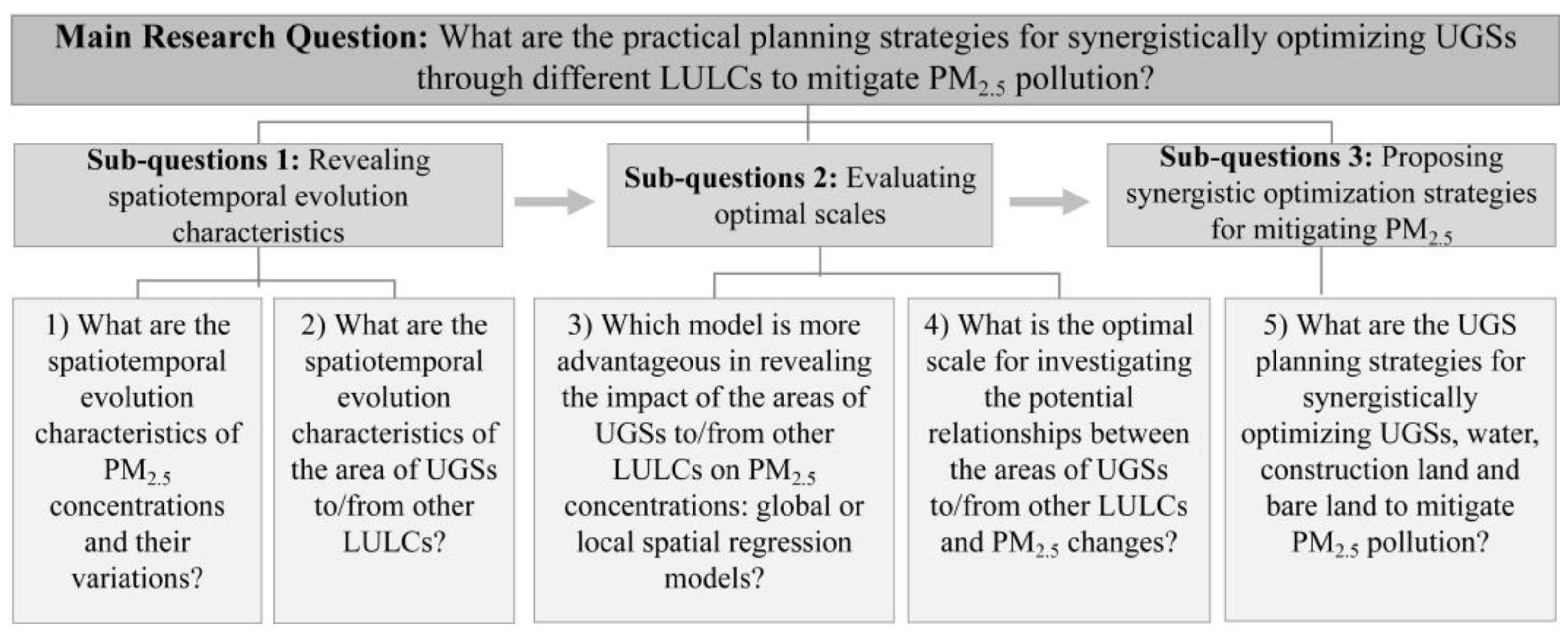
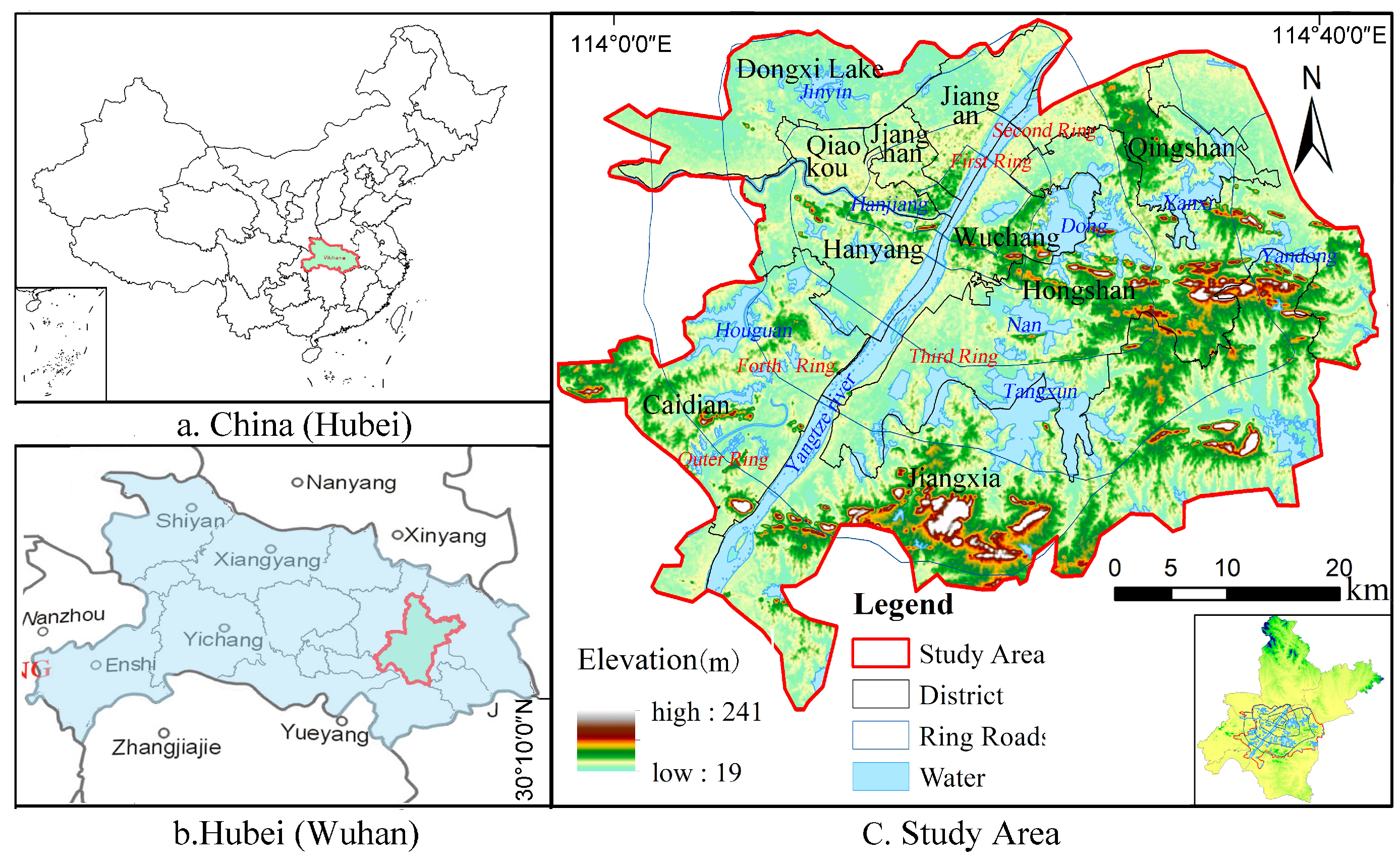
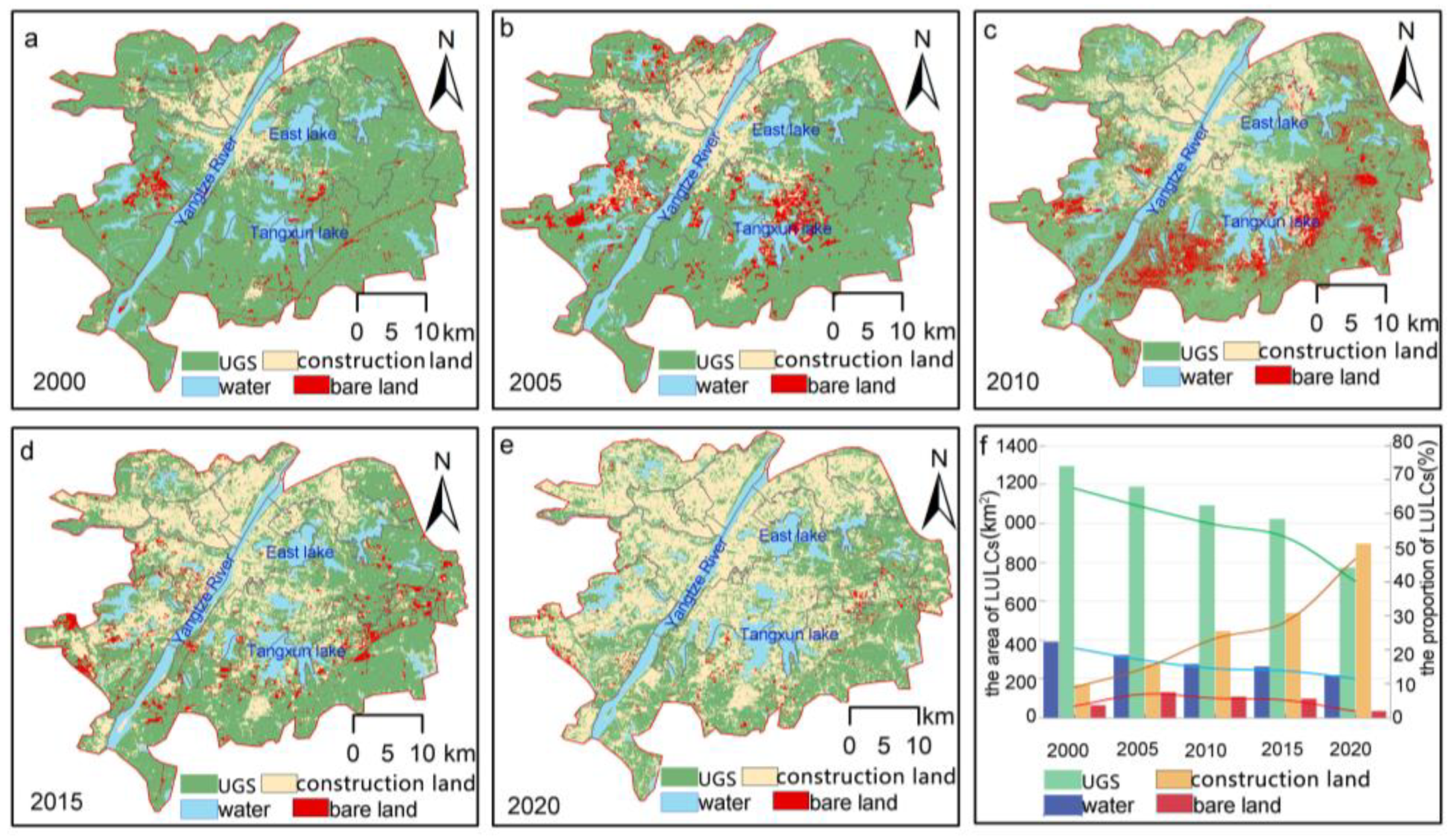






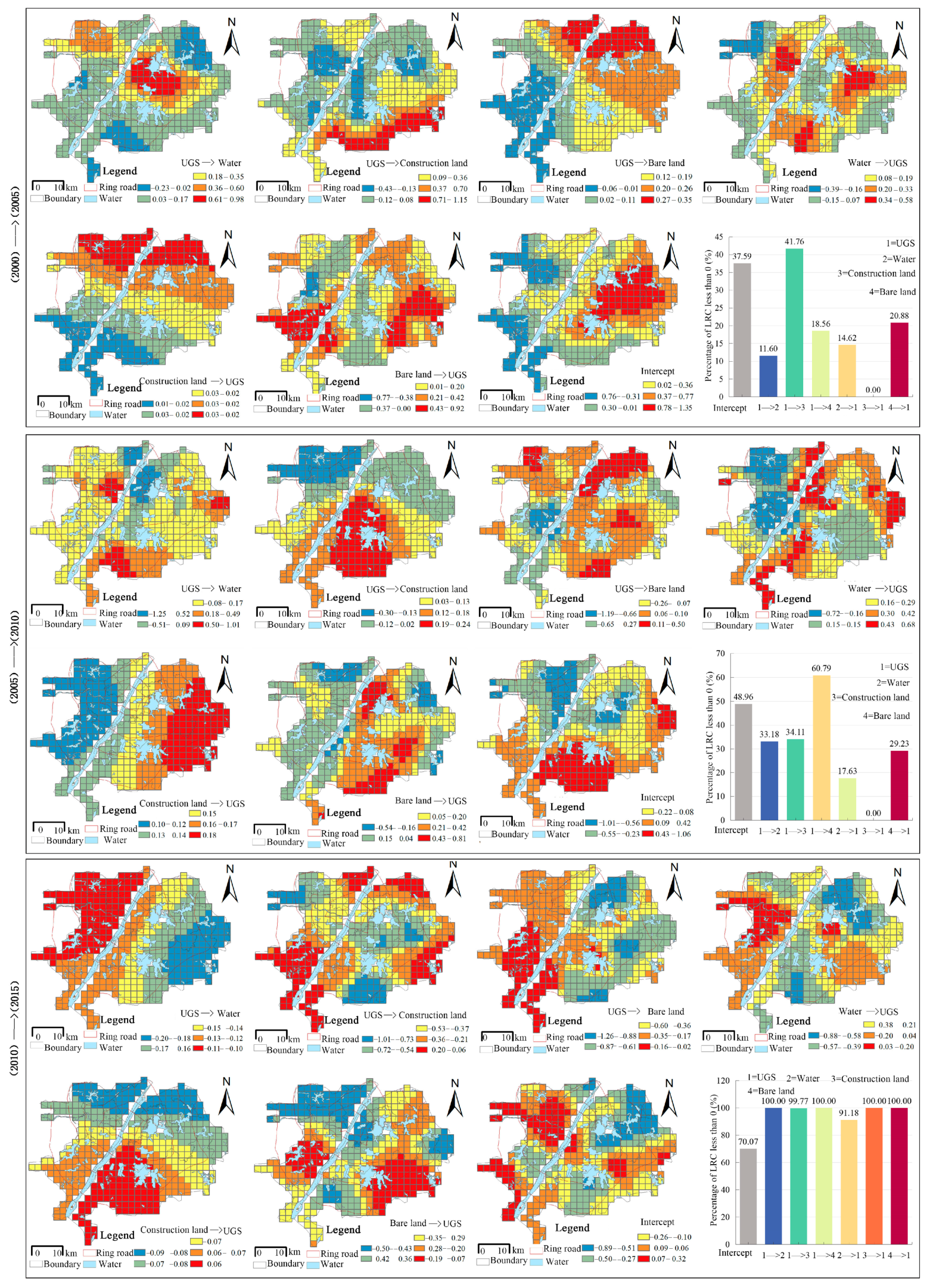
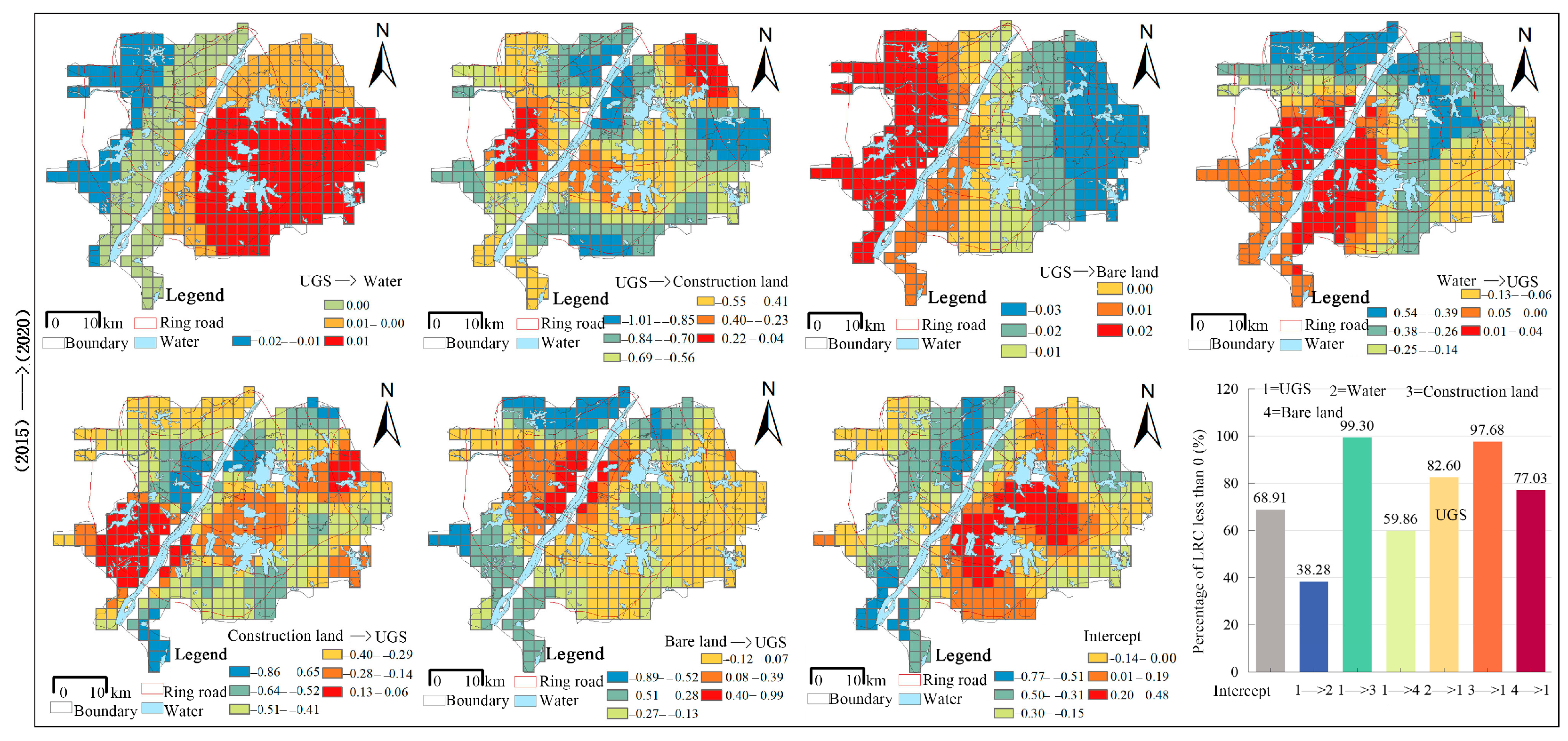
| Evolution Stages | Parameters | 1 km × 1 km | 2 km × 2 km | 3 km × 3 km | 5 km × 5 km |
|---|---|---|---|---|---|
| 2000–2005 | RSS | 1632.67 | 374.83 | 169.45 | 46.80 |
| AIC | 4846.75 | 1179.28 | 534.24 | 187.42 | |
| R2 | 0.06 | 0.13 | 0.11 | 0.32 | |
| Adj.R2 | 0.06 | 0.12 | 0.08 | 0.26 | |
| 2005–2010 | RSS | 1635.04 | 389.04 | 171.24 | 52.20 |
| AIC | 4849.28 | 1195.32 | 536.24 | 194.96 | |
| R2 | 0.06 | 0.10 | 0.10 | 0.24 | |
| Adj.R2 | 0.06 | 0.09 | 0.07 | 0.17 | |
| 2010–2015 | RSS | 1474.13 | 266.59 | 166.44 | 68.60 |
| AIC | 4668.81 | 1032.41 | 530.84 | 213.81 | |
| R2 | 0.15 | 0.38 | 0.12 | 0.01 | |
| Adj.R2 | 0.15 | 0.37 | 0.10 | - | |
| 2015–2020 | RSS | 1565.56 | 226.46 | 140.44 | 53.33 |
| AIC | 4773.63 | 962.10 | 498.57 | 196.43 | |
| R2 | 0.10 | 0.48 | 0.26 | 0.23 | |
| Adj.R2 | 0.10 | 0.47 | 0.24 | 0.15 |
| Evolution Stages | Parameters | 1 km × 1 km | 2 km × 2 km | 3 km × 3 km | 5 km × 5 km | ||||
|---|---|---|---|---|---|---|---|---|---|
| GWR | MGWR | GWR | MGWR | GWR | MGWR | GWR | MGWR | ||
| 2000–2005 | Bandwidths | 300.00 | - | 56.00 | - | 85.00 | - | 65.00 | - |
| RSS | 896.21 | 169.58 | 136.84 | 128.93 | 89.06 | 70.48 | 30.10 | 23.31 | |
| AIC | 3970.48 | 2791.23 | 1003.89 | 927.07 | 473.08 | 428.71 | 174.05 | 166.44 | |
| R2 | 0.49 | 0.90 | 0.68 | 0.70 | 0.53 | 0.629 | 0.564 | 0.66 | |
| Adj.R2 | 0.46 | 0.85 | 0.58 | 0.62 | 0.44 | 0.556 | 0.462 | 0.56 | |
| 2005–2010 | Bandwidths | 300.00 | - | 62.00 | - | 65.00 | - | 65.00 | - |
| RSS | 937.60 | 334.06 | 159.51 | 127.09 | 82.64 | 71.96 | 38.86 | 31.51 | |
| AIC | 4045.95 | 2888.04 | 1044.57 | 945.68 | 488.46 | 451.27 | 192.96 | 185.36 | |
| R2 | 0.46 | 0.81 | 0.63 | 0.71 | 0.57 | 0.62 | 0.44 | 0.54 | |
| Adj.R2 | 0.43 | 0.76 | 0.52 | 0.62 | 0.45 | 0.53 | 0.3 | 0.41 | |
| 2010–2015 | Bandwidths | 300.00 | - | 80.00 | - | 78.00 | - | 57.00 | |
| RSS | 572.58 | 318.18 | 144.39 | 124.28 | 92.84 | 81.45 | 42.67 | 33.13 | |
| AIC | 3192.19 | 2672.58 | 944.04 | 884.76 | 488.65 | 473.00 | 205.83 | 194.73 | |
| R2 | 0.67 | 0.82 | 0.67 | 0.71 | 0.51 | 0.57 | 0.38 | 0.52 | |
| Adj.R2 | 0.65 | 0.78 | 0.59 | 0.65 | 0.41 | 0.47 | 0.20 | 0.36 | |
| 2015–2020 | Bandwidths | 300.00 | - | 67.00 | - | 69.00 | - | 68.00 | - |
| RSS | 544.74 | 326.03 | 107.52 | 86.70 | 74.76 | 61.76 | 46.68 | 35.95 | |
| AIC | 3102.13 | 2612.38 | 853.78 | 765.23 | 459.56 | 410.95 | 202.14 | 194.36 | |
| R2 | 0.69 | 0.81 | 0.75 | 0.80 | 0.61 | 0.68 | 0.324 | 0.45 | |
| Adj.R2 | 0.67 | 0.78 | 0.69 | 0.75 | 0.51 | 0.61 | 0.18 | 0.33 | |
| Evolution Stages | Scales | Intercept | 1 → 2 | 1 → 3 | 1 → 4 | 2 → 1 | 3 → 1 | 4 → 1 |
|---|---|---|---|---|---|---|---|---|
| 2000–2005 | 1 km | 46 | 376 | 1741 | 64 | 53 | 539 | 112 |
| 2 km | 43 | 69 | 43 | 212 | 64 | 430 | 45 | |
| 3 km | 43 | 177 | 182 | 94 | 138 | 44 | 162 | |
| 5 km | 48 | 48 | 46 | 65 | 48 | 67 | 67 | |
| 2005–2010 | 1 km | 43 | 253 | 46 | 146 | 70 | 44 | 70 |
| 2 km | 43 | 43 | 216 | 46 | 55 | 430 | 44 | |
| 3 km | 44 | 99 | 55 | 82 | 45 | 189 | 133 | |
| 5 km | 46 | 46 | 52 | 67 | 67 | 67 | 65 | |
| 2010–2015 | 1 km | 43 | 46 | 364 | 100 | 480 | 46 | 176 |
| 2 km | 43 | 409 | 60 | 52 | 57 | 430 | 99 | |
| 3 km | 45 | 79 | 62 | 189 | 102 | 72 | 49 | |
| 5 km | 44 | 44 | 67 | 67 | 44 | 48 | 44 | |
| 2015–2020 | 1 km | 43 | 1734 | 46 | 1741 | 411 | 72 | 331 |
| 2 km | 43 | 430 | 44 | 428 | 99 | 44 | 47 | |
| 3 km | 45 | 189 | 48 | 189 | 189 | 45 | 189 | |
| 5 km | 53 | 67 | 52 | 44 | 53 | 67 | 67 |
Disclaimer/Publisher’s Note: The statements, opinions and data contained in all publications are solely those of the individual author(s) and contributor(s) and not of MDPI and/or the editor(s). MDPI and/or the editor(s) disclaim responsibility for any injury to people or property resulting from any ideas, methods, instructions or products referred to in the content. |
© 2024 by the authors. Licensee MDPI, Basel, Switzerland. This article is an open access article distributed under the terms and conditions of the Creative Commons Attribution (CC BY) license (https://creativecommons.org/licenses/by/4.0/).
Share and Cite
Bi, S.; Chen, M.; Tian, Z.; Jiang, P.; Dai, F.; Wang, G. Optimizing Urban Green Spaces for Air Quality Improvement: A Multiscale Land Use/Land Cover Synergy Practical Framework in Wuhan, China. Land 2024, 13, 1020. https://doi.org/10.3390/land13071020
Bi S, Chen M, Tian Z, Jiang P, Dai F, Wang G. Optimizing Urban Green Spaces for Air Quality Improvement: A Multiscale Land Use/Land Cover Synergy Practical Framework in Wuhan, China. Land. 2024; 13(7):1020. https://doi.org/10.3390/land13071020
Chicago/Turabian StyleBi, Shibo, Ming Chen, Zheng Tian, Peiyi Jiang, Fei Dai, and Guowei Wang. 2024. "Optimizing Urban Green Spaces for Air Quality Improvement: A Multiscale Land Use/Land Cover Synergy Practical Framework in Wuhan, China" Land 13, no. 7: 1020. https://doi.org/10.3390/land13071020




